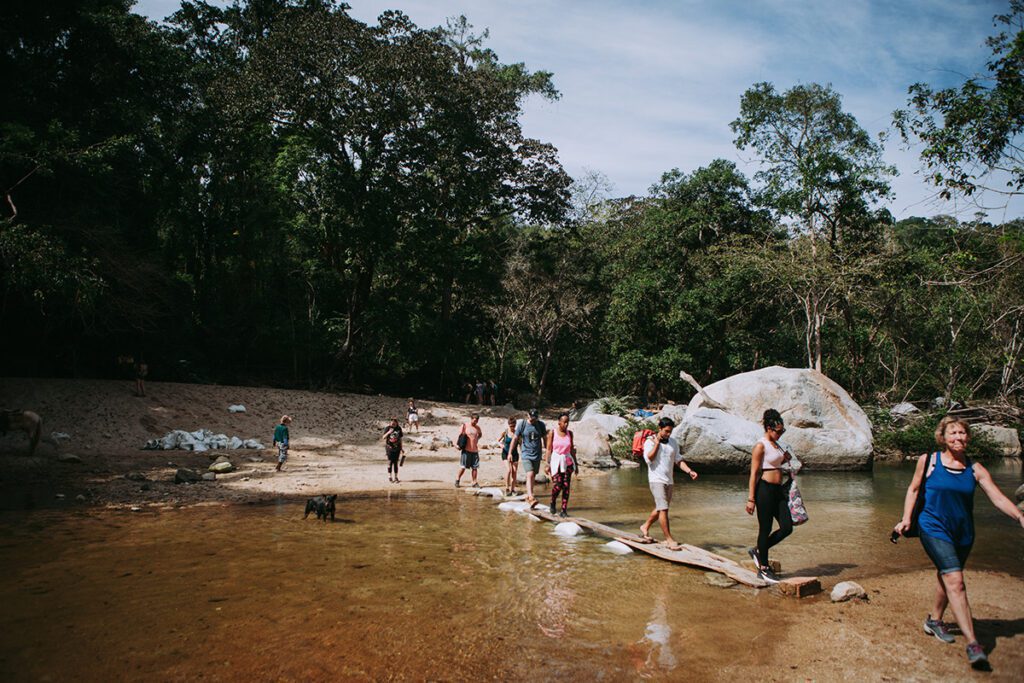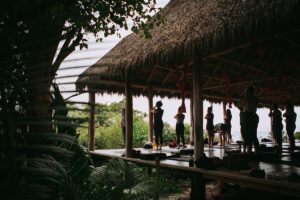A yoga retreat is not just a vacation; it’s an opportunity for transformation, rejuvenation, and personal growth. As a yoga instructor or retreat organizer, you have the power to create a profound and memorable experience for your participants. To ensure your yoga retreat is a resounding success, you need to focus on several key ingredients that go beyond the location and yoga classes. In this guide, we’ll explore the essential elements that will help you craft a truly exceptional yoga retreat.
1. A Meaningful Retreat Theme
Every successful yoga retreat begins with a clear and compelling theme. Your theme sets the tone for the entire experience and provides a unifying thread for your participants. It could be centered around mindfulness, self-discovery, nature immersion, or any other concept that deeply connects with the values and aspirations of your intended participants. Make sure your theme aligns with your retreat’s purpose and the transformation you intend to facilitate.
We are deeply inspired by the teachings of Hargobind Khalsa whose podcasts Yoga Retreats Secrets are available freely on Spotify. For Hargobind, yoga retreats can be transformed into meaningful experiences by embracing the concept of the Hero’s Journey. Just as in many cultures, there is a universal story of a student seeking greatness who meets a guide at the frontier. The guide equips the student with tools and wisdom to become a champion, resulting in a transformation. This concept is of course beautifully illustrated in the Bhagavad Gita (Arjuna learns from his guru Sri Krishna), but really you see it all cultures, even in stories like Star Wars (Yoda is Luke’s teacher).
In the context of yoga retreats, yoga instructors become the guides, leading their students to new frontiers, which could be exotic locations or local sanctuaries. During the retreat, participants engage in various practices, including yoga, meditation, rituals (such as the temazcal), and other positive transformative activities. These experiences provide them with fresh perspectives, new beliefs, and a sense of personal growth. The Hero’s Journey is the psychological motivation that keeps people seeking these retreats as they return home feeling transformed and enriched.
Incorporating the Hero’s Journey concept into yoga retreats elevates them beyond mere vacations, making them powerful and meaningful experiences rather than commodities.
2. A Balanced Daily Schedule

Designing a balanced daily schedule is crucial. Participants should have ample time for yoga and meditation sessions, but it’s equally important to allow for downtime, self-reflection, and exploration. Avoid overloading the schedule to ensure that everyone has the opportunity to recharge and absorb the teachings.
You can read more tips about how to craft the best yoga retreat schedule on our popular Blog Post: How to create a balanced 7-day schedule for your yoga retreat
Still paraphrasing some of Hargobind’s insights which we love: when designing retreat schedules, you can categorize them into two main approaches: Width and Depth. “Depth” retreats focus on diving deep into a single aspect or practice, such as an intensive week dedicated to mastering a specific yoga pose like Handstand. On the other hand, “Width” retreats encompass a broad spectrum of experiences, including various yoga styles, excursions, adventures, and workshops.
Over our 14 years experience at Xinalani, we hosted over a thousand retreats and we’ve seen a lot of different ideas work. In our opinion though, to create a well-rounded and impactful retreat experience, consider incorporating diverse categories like fitness, community-building, adventure, mindfulness, and technique workshops into your schedule. These elements contribute to the overall richness of the retreat and appeal to a wide range of participants.
The depth of your retreat can influence the pricing, as specialized instructors with in-depth knowledge often command higher fees. However, for instructors who possess a broad skill set, offering a wide range of experiences can also be highly appealing to participants.
When developing your retreat schedule, reflect on the practices, classes, and frameworks that have personally transformed you. Share these transformative elements with your students, as they are likely to resonate with others seeking positive change. Additionally, if you notice a gap between what you practice and what you teach, consider creating a special workshop to bridge that divide, providing valuable insights to your participants.
3. Nurturing Connection and Community: Cultivating the Yoga Retreat Bond

A yoga retreat isn’t just about individual practice; it’s an opportunity for participants to form meaningful connections and become part of a supportive community. This sense of community is often one of the most magical and transformative aspects of the retreat experience. To foster a profound environment of connection, consider the following in-depth strategies:
a. Ice-Breaker Activities: At the beginning of the retreat, organize ice-breaker activities that encourage participants to get to know one another in a relaxed and fun setting. These activities can range from partner yoga poses to storytelling sessions where everyone shares a memorable life experience. Ice-breakers break down initial barriers, paving the way for authentic interactions.
b. Group Discussions: Plan structured group discussions where participants can explore topics related to their yoga journey, personal growth, and life experiences. These discussions provide a platform for open dialogue, sharing insights, and learning from one another. Topics can range from yoga philosophy and mindfulness to personal transformation stories.
c. Communal Meals: Meals are an excellent opportunity for participants to bond over delicious, nourishing food. Arrange communal dining settings where everyone comes together to share meals, stories, and laughter. Consider themed dinners that align with the retreat’s theme or local cuisine that provides a unique cultural experience.
d. Group Rituals: Incorporate group rituals into the retreat schedule. These can include sunrise or sunset meditations, chanting sessions, or even group hikes to special natural locations. These shared experiences create a deep sense of unity and connection among participants.
4. Mindful Workshops and Practices: Deepening Yoga and Mindfulness Understanding

Workshops and practices are the heart of a yoga retreat, providing participants with opportunities for personal growth and a deeper understanding of yoga and mindfulness. To enrich this aspect of your retreat, consider the following in-depth approaches:
a. Breathwork Exploration: Offer workshops and sessions dedicated to exploring the profound impact of breathwork. Participants can delve into various breathing techniques, such as pranayama, and learn how conscious breathing can enhance their yoga practice and daily life.
b. Meditation Immersion: Develop workshops that guide participants through different meditation techniques. Teach mindfulness meditation, loving-kindness meditation, or transcendental meditation, allowing attendees to discover the benefits of a regular meditation practice and how it aligns with the retreat’s theme.
c. Yoga Philosophy: Deepen participants’ understanding of yoga philosophy by offering workshops that explore ancient texts like the Yoga Sutras of Patanjali or the Bhagavad Gita. These sessions can delve into the philosophical foundations of yoga and how they relate to modern life and personal growth.
d. Creative Self-Expression: Encourage creative self-expression through workshops that incorporate art, writing, or movement. Activities like mandala drawing, journaling, or dance can help participants connect with their inner selves and explore mindfulness from a creative perspective.
By including these mindful workshops and practices in your retreat schedule, you provide participants with a holistic and enriching experience. These sessions not only deepen their yoga practice but also empower them with tools and insights that they can carry into their everyday lives, fostering lasting transformation and personal growth.
5. Nourishing Cuisine

Healthy, nourishing food is an essential part of any yoga retreat. Find a place that provides a menu that caters to various dietary preferences and allergies. Fresh, organic ingredients can enhance the overall wellness experience and provide participants with the energy they need for their daily practices.
6. Marketing and Promotion Strategies for Reach
To ensure your retreat reaches the right audience, invest in effective marketing and promotion strategies. Utilize social media, email marketing, and partnerships with yoga influencers to spread the word. Engage with potential participants by sharing inspiring content related to your retreat’s theme.
7. Professional Guidance
If you’re not an expert in all areas of yoga and wellness, consider bringing in guest instructors or facilitators who specialize in specific aspects of the retreat’s theme. Their expertise can add depth and diversity to the retreat’s offerings.
8. Seamless Logistics
Smooth logistics are vital for a successful retreat. Ensure that transportation, accommodations, and daily activities run seamlessly. Anticipate potential challenges and have contingency plans in place to address them.
9. Engaging Activities

While yoga is the core of your retreat, offer a variety of engaging activities to cater to different interests. Guided hikes, nature excursions, art workshops, or spa treatments can complement the yoga practice and provide a well-rounded experience.
10. Participant Feedback and Adaptation
Throughout the retreat, actively seek feedback from participants to understand their needs and preferences. Be willing to adapt and modify the schedule or activities based on their input. This responsiveness can lead to a more personalized and satisfying experience for everyone involved.
Final Words

Incorporating these essential ingredients into your yoga retreat planning will help you create an unforgettable and transformative experience for your participants. Remember that the success of your retreat isn’t just measured by the number of attendees but by the positive impact it has on their lives. By focusing on these elements, you can ensure that your yoga retreat is a truly enriching and life-changing event.





